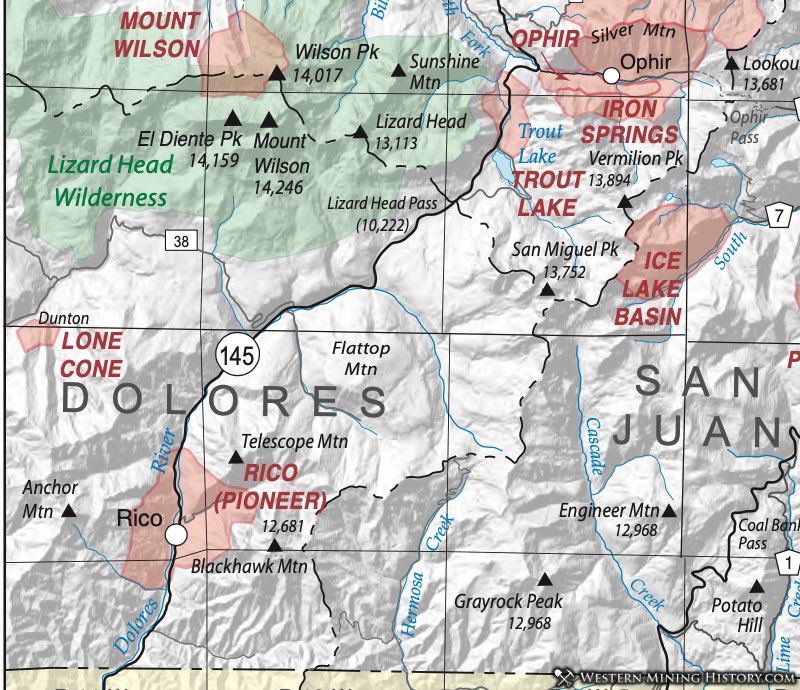
Lone Cone District
The Lone Cone District is a small district that is commonly considered part of the larger Rico District. Henderson (1926) noted the district by name. Vanderwilt (1947) also separates the district and provides some production numbers. Both Dunn (2003) and mindat.org note the district, locating it 16 miles northwest of the town of Rico. They note the name Dunton District had occasionally been used.
For this report, the Lone Cone is considered part of the Rico District. Refer to the Rico District for more information.
Rico District (aka Pioneer District)
The Rico District is the only major district in Dolores County, occurring on the southwest flank of the San Juan Mountains in the far eastern part of that county. Henderson (1926) used the term Pioneer District, which was also recognized by Vanderwilt (1947) and Dunn (2003). The most complete (and recent) report on the district - McKnight (1974) does not mention the term Pioneer District at all.
Early reports on the geology and some specific mines were produced by Farish (1892), Cross and Spencer (1900), Cross and Ransome (1905), and Ransome (1901).
Varnes (1947) provided a special section in Vanderwilt (Ibid). Summarizing Varnes and McKnight, the Rico Mountains are carved from a low, elliptical, structural dome comprised of a central igneous core draped with sedimentary rocks. The sedimentary sequence ranges from Precambrian to Jurassic. Successively, the units consist of Precambrian schist, quartzite and diorite, Devonian Ouray limestone and Mississippian Leadville limestone, Pennsylvanian Larsen quartzite and Heermosa formation (shale, sandstone and thin limestones), Permian Rico formation (sandstone and sandy shales) and Cutler formation (Varnes, Ibid; McKnight, Ibid).
Igneous rocks from the core of the uplift - primarily a monzonite stock and dikes and sills of a hornblende latite porphyry. Subsidiary alaskite porphyry and a single lamprophyre dike can be found. The igneous activity is Laramide in age (except for one small Pliocene body, Cunningham et al., 1994.)
McKnight (Ibid) described four main types of deposits in the district. First is massive sulfide replacement of limestones (primarily in the Hermosa Formation); second is contact-metamorphic deposits in limestone; third are veins on fracture and faults in the Hermosa Formation; and fourth are replacement deposits in residual debris where gypsum had dissolved from the Hermosa Formation. The Rico District exhibited a diverse mineralogy.
Engel (1968) relates a very readable history of the Rico area. According to his account, galena lodes were located as early as 1860. Exploration from Santa Fe pushed into the area and located the Pioneer lode in 1869, later to become the Shamrock and Potter Mines, and the district took on the name Pioneer District. A major rush of prospectors began in 1879 and the town of Rico was established as the second town in Ouray County. The boom was accelerated by the arrival of the railroad in 1891.
In the succeeding years, 59 mines operated in the district, employing up to 2000 miners. Fourteen hotels graced the boomtown of Rico. Several periods of boom and bust have followed, although mines operated as late as the 1960s. Currently, at least one company is interested in pursuing development of a porphyry molybdenum deposit that has been known for quite some time.